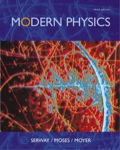
(a)
Show that the current density
(a)
Answer to Problem 11P
The current density
Explanation of Solution
Write the expression for the current density,
Here,
Write the expression for the drift velocity,
Here,
Write the expression for the drift velocity,
Here,
Compare (II) and (III),
Conclusion:
Substitute (II) and (IV) in (I),
Therefore, the current density
(b)
Show that the both electrons and holes are present when
(b)
Answer to Problem 11P
The both electrons and holes are present when
Explanation of Solution
Write the expression for the current density,
Here,
Write the expression for the current density,
Here,
Write the expression for the current density of the electrons,
Here,
Write the expression for the current density of the holes,
Here,
Conclusion:
Substitute (VII), (VIII) and (IX) in (VI),
Therefore, the both electrons and holes are present when
(c)
The drift speed of an electron .
(c)
Answer to Problem 11P
The drift speed of an electron is
Explanation of Solution
From part (a), the equation (III)
Write the expression for the drift speed of an electron,
Here,
Conclusion:
Substitute
Therefore, the drift speed of an electron is
(d)
The resistivity of sample.
(d)
Answer to Problem 11P
The resistivity of sample is
Explanation of Solution
From part (b), take the equation (X)
Write the expression for the electrical conductivity
Write the expression for the resistivity of sample,
Here,
Conclusion:
Substitute
Substitute
Therefore, the resistivity of sample is
Want to see more full solutions like this?
Chapter 12 Solutions
EBK MODERN PHYSICS
- Can a semiconductor be used to describe the distinction between a conductor and an insulator? Why not use a graph to support your arguments?arrow_forwardFor a certain semiconductor, the Fermi energy is in the middle of its band gap. If the temperature of the semiconductor is 285 K, find the probability that a state at the bottom of the conduction band is occupied if the band gap is 0.005eV.arrow_forwardA non-pure semiconductor has an energy gap of 1ev and a hole density of 1022m−3 at 300K and an electron density of 1016 m−3. Find the Fermi Level location at 500k.arrow_forward
- For a certain semiconductor, the Fermi energy is in the middle of its band gap. If the temperature of the semiconductor is 285 K, find the probability that a state at the bottom of the conduction band is occupied if the band gap is 1.5 eV.arrow_forwardBased on the energy band gap working principle, (i) Plot the output of a semiconductor temperature sensor. (ii) Explain the underlying physics which contribute to the output behavior of the semiconductor temperature sensor (plotted in Q1 (c)(i)). (iii) Explain one drawback of using this semiconductor temperature sensor.arrow_forwardThe Fermi energy of a doped semiconductor is different from that of a pure semiconductor. Consider silicon, where the energy difference between the top of the valence band and the bottom of the conduction band is 1.11 eV. At a temperature of 300 K the Fermi energy of pure silicon lies approximately between the bottom of the conduction band and the top of the valence band. (a) Calculate the probability of occupying a state at the bottom of the conduction band. Consider now that the silicon has been doped with donor atoms that introduce a state at 0.15 eV below the conduction band background. Doping also caused the Fermi level to be shifted to an energy 0.11 eV below the bottom of the conduction band. (b) Under these conditions, calculate the occupancy of the lower end of the conduction band. (c) Calculate the probability that the level introduced by the donor impurities is occupied.arrow_forward
- Determine the thermal-equilibrium concentrations of electrons and holes in silicon at T =300 K if the Fermi energy level is 0.2 eV above the valence-band energy. Assume that the bandgap of semiconductor is 1 eV. Nc=2x1019 cm-3 and Nv=1x1019 cm-3. Take kT=25.875 meVarrow_forwardThe carrier effective masses in a semiconductor are mn*= 1.21 m0 and mp*= 0.70 m0. Determine the position of the intrinsic Fermi level with respect to the center of the bandgap at T= 300 K.arrow_forwardMost solar cells are semiconductor-based. If most solar radiation has a wavelength of less than 1m, what should the band gap of the solar cell material be? Silicon has a band gap of 1.14 eV. Is silicon a suitable solar cell material?arrow_forward
 Modern PhysicsPhysicsISBN:9781111794378Author:Raymond A. Serway, Clement J. Moses, Curt A. MoyerPublisher:Cengage Learning
Modern PhysicsPhysicsISBN:9781111794378Author:Raymond A. Serway, Clement J. Moses, Curt A. MoyerPublisher:Cengage Learning Glencoe Physics: Principles and Problems, Student...PhysicsISBN:9780078807213Author:Paul W. ZitzewitzPublisher:Glencoe/McGraw-Hill
Glencoe Physics: Principles and Problems, Student...PhysicsISBN:9780078807213Author:Paul W. ZitzewitzPublisher:Glencoe/McGraw-Hill

